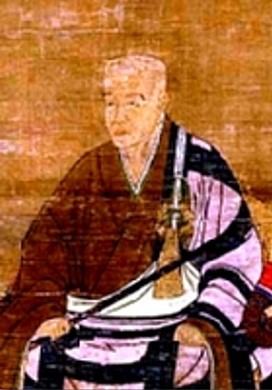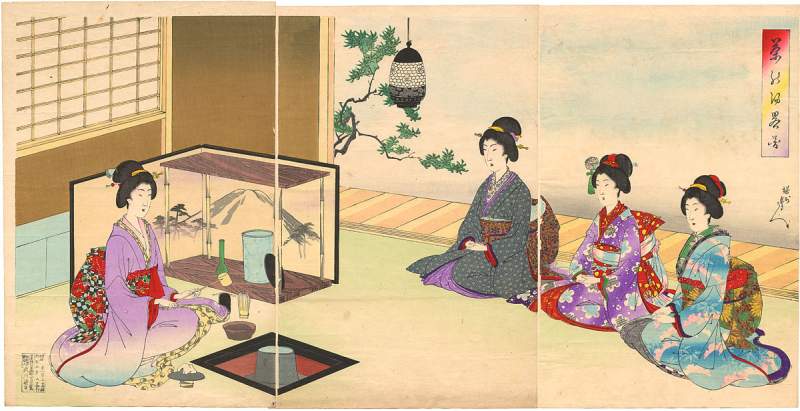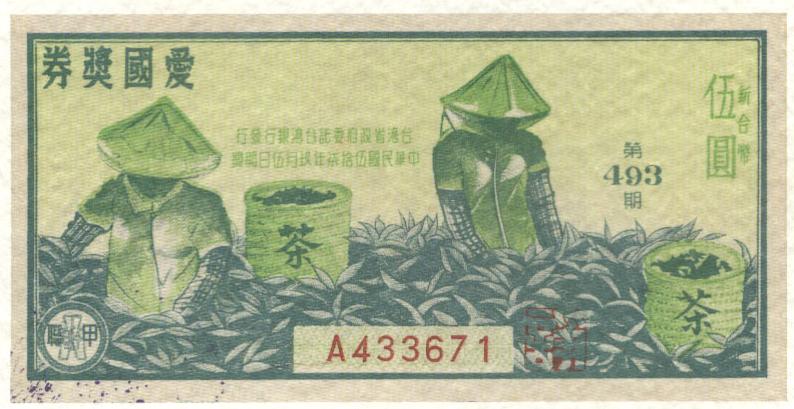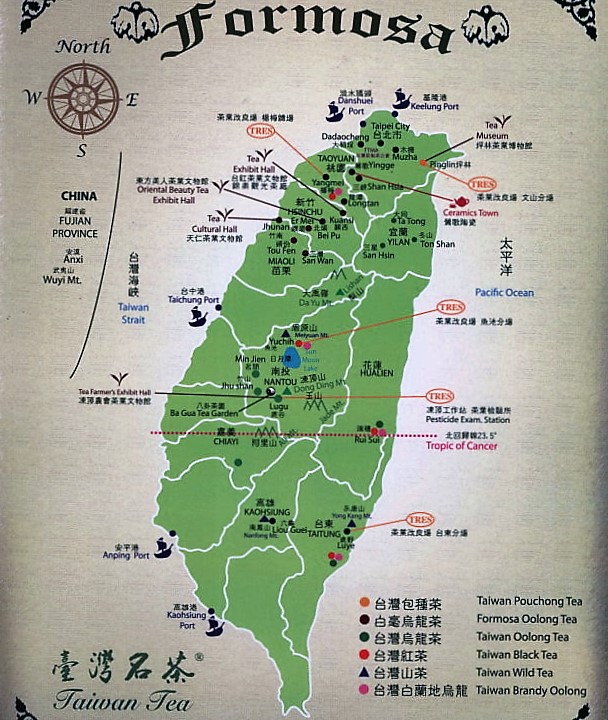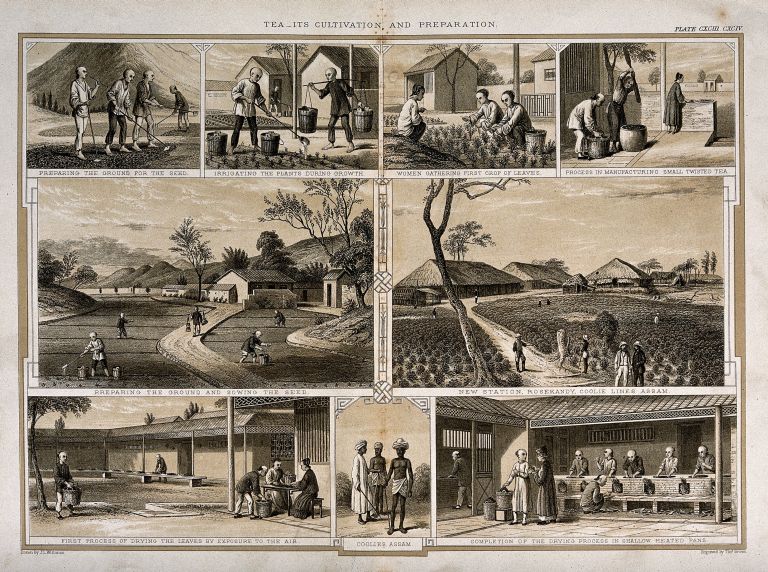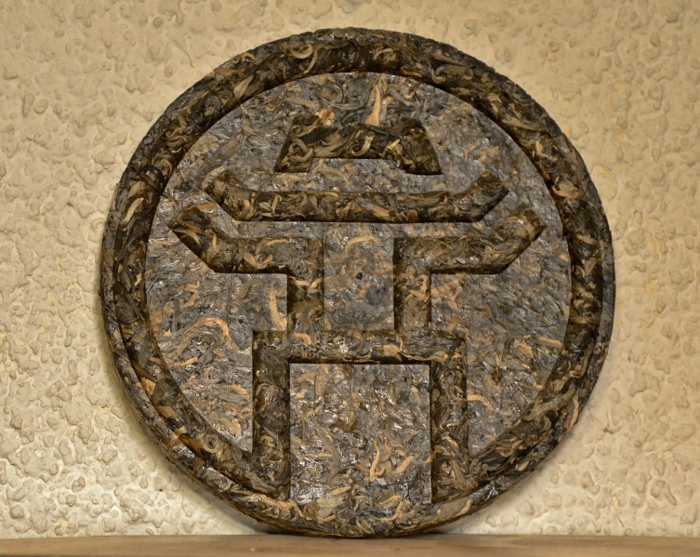In Lesson 10/2 we have seen how tea culture developed in China, the mother of all tea cultures. In other, neighboring home countries of the tea tree on the other hand, including Laos, Myanmar, Thailand and Vietnam, the processing and consumption of tea long remained reserved to some mountain tribes migrated here from China. It was not until the second millennium AD that tea culture began to spread beyond China via newly discovered travel and trade routes. Obviously, this would initially be a spread of tea culture in Asia. The earliest example of this is Japan, where Buddhist monks tried to cultivate tea seeds brought from China already very early.
1. Beginnings and Development of the Japanese Tea Culture
1.1 Beginnings of the Tea Cultivation in Japan
Japan’s first contact with tea as a beverage dates back to 552 AD. Back then, Buddhist monks brought tea with them from study trips to China. In 805 AD then, the monks Saicho and Kukai brought back the first tea seeds from such a study trip . The resulting first tea plants in Japan grew on the island of Kyushu on the southern tip of Japan, still one of Japan’s largest growing areas today.
However, the second attempt at planting tea by the monk Eisei in Fukuoka in 1168 AD is considered the actual spark of Japanese tea culture. Eisei did not limit himself to planting and processing tea, but also successfully propagated tea consumption on a broad basis. His efforts and later plantings by his students in Uji mark the actual beginning of Japan’s tea culture. That is why Uji enjoys a special reputation among Japan’s tea-growing regions to this day. And to this day, almost everything in Japanese tea culture revolves around green tea. Unlike in China, the Japanese method of stopping the oxidation process in the tea leaves is by steaming. Japanese green teas therefore differ greatly from Chinese ones, also in terms of taste
In addition to tea seeds, Eisei also brought the method of making powdered green tea from tencha leaves from China. As was customary in China at the time, he also made tencha by removing the stems and leaf veins from the tea leaves. This was then ground in stone mills into the fine green tea powder that we know today as matcha tea.
1.2. Development of the Tea Culture in Japan
Since then, the tea culture in Japan has developed into a “green tea culture” of its own. For example, the Japanese tea ceremony, revolving all around preparing matcha, widely reflects the national culture of Japan. Also, Japanese Bancha, Sencha, Kabusecha, Shincha and Gyokuro teas represent a category of it own within the world of tea. This in turn enjoys growing popularity among tea lovers worldwide and is about to establish a “fan club” of its very own.
The largest two tea-growing regions in Japan today are Shizuoka and Kagoshima. Of these, Shizuoka is the region with the highest quantity output. Kagoshima, on the southern tip of the country, on the other hand, enjoys a reputation for particularly good quality. In addition, the traditional Uji growing area and a number of other small growing areas continue to play a role in Japanese tea cultivation.
Tea production in Japan is characterized by a particularly high level of technology and automation, from picking to processing. On the one hand, this development is due to the generally high tech-affinity in Japan. On the other hand, the high wage level in the country makes picking and processing by hand too expensive. Today, traditional handicraft only occurs whith the production of small quantities by reputed masters for competition purposes.
2. Beginnings and Development of Tea Culture in Taiwan
The further spread of tea culture in Asia took place from the 17th century only. In spite of its development in a geographical and cultural proximity to China, the individual development of tea cultivation and culture in Taiwan eventually shaped an independent tea culture.
2.1 Beginnings of Tea Cultivation in Taiwan
When refugees from China first set foot on the island, named “Formosa” by the Portuguese, at the beginning of the 17th century, Taiwan was a wild, almost completely uninhabited place. They brought tea seeds with them from nearby Fujian, which they planted in their new homeland. Their endeavors should ultimately meet success. Not only did the tea plant grow and flourish in Formosa, but soon new cultivars were emerging. These were well adapted to the new environment and significantly contributed to shaping nowadays Taiwan’s tea culture.
Taiwan’s focus on oolong tea cultivars logically derives from the origin of the tea seeds. After all, the Chinese province of Fujian is still one of THE four regions of origin for oolong teas. Nevertheless, there have always been cultivars in Taiwan that are preferentially used for producing green and black teas. Native tea tree varieties, on the other hand, which the island also has, long remained hidden in the fog of oblivion.
2.2 Development of the Tea Culture in Taiwan
Due to the obvious contextual parallels and the geographical and cultural proximity, the Chinese tea culture initially greatly influenced the tea culture in Taiwan. For example, the Taiwanese tea ceremony mainly revolves around the ritual preparation of oolong tea, too. Nevertheless, the Taiwanese tea culture has developed its own identity over the years. And the development of new tea cultivars as a major national project greatly contributes to this.
Traditional Taiwanese oolong teas such as Oriental Beauty Oolong Tea enjoy great popularity all over the world today. But there’s more than that to modern Taiwan tea history… Since the beginning of the 20th century and increasingly since the 1960s and 1970s, the Taiwanese government has been running targeted programs to develop new tea cultivars. These are targeting specific requirement profiles in terms of a desired taste and / or adaption to given environmental conditions. One example is the breeding of particularly high-yielding, pest-resistant or climate-insensitive cultivars, which the country is now successfully exporting.
3. Beginnings and Development of Tea Culture in India
Driving force of the further spread of tea culture in Asia was the sea trade between China and Europe. Starting from the second half of the 17th century, main actors were the colonial powers Netherlands and Great Britain. That this, the Dutch East India Company did the pioneering work, but should soon be superseded by a Sino-European trade monopoly of an otherwise eponymous British company that lasted almost 200 years.
However, the British colonial power’s sea trade with China was soon to result in conflicts between the two countries. In the early 19th century, England began to think about alternatives to buying tea from China. In this context, the colonized and therefore easily controllable India came into focus as a potential cultivation country for tea. On the one hand, this was countered by the fact that the export of tea plants and seeds from China was prohibited. On the other hand, the details of tea processing were still a well-kept Chinese secret at the time.
3.1 Beginnings of Tea Cultivation in India
In May 1848, the British botanist Robert Fortune traveled to China on behalf of the East India Trading Company. Om Not only had the passionate plant collector previously made extensive journeys there. Also, he had become a connoisseur of Chinese culture and language during these visits. AND: he was familiar with some of the tea-growing areas in China, which he had studied on previous trips. All of this qualified him for his current assignment, which essentially consisted of gaining further knowledge about the cultivation and processing of tea locally in China as well as bringing tea seeds and cuttings to India.

In the following years Robert Fortune secretly shipped cuttings and seedlings of tea plants to India. In addition, he was able to persuade some Chinese tea farmers to accompany him to India to help set up the tea plantations and tea production there. Soon, British scientists in the Botanical Garden of Calcutta succeeded in propagating the tea plants sent by Robert Fortune.
Meanwhile, another Briton, Robert Bruce, had discovered native tea trees in the northeast Indian region of Assam. Soon, Robert Bruce and his brother Charles Alexander Bruce began to develop organized tea cultivation in Assam. At the same time, the fertile highland region of Darjeeling, southeast of Assam, was chosen as a cultivation area for tea plants from Assam as well as for the new China cultivars .
3.2 Development of the Tea Culture in India
Under the leadership of British noblemen and aristocrats, as well as some wealthy Indian favorites of the British crown, large estates in Darjeeling were planted with tea plants. This is how the large colonial style “Darjeeling Tea Estates” came about that still shape Darjeeling’s tea industry today.
For the next 150 years, tea cultivation in India was synonymous with the production of cheap black tea for the European and US American mass markets. However, the sustained western trend towards higher quality tea meanwhile has bourne sweet fruits in India, too. But not only quality comes at a high level from India today, but also a much more diversified tea portfolio. As a result, the classic of Indian tea, black tea, suddenly comes in a wide variety of appearances. The spectrum ranges from the sparkling, spring-fresh First Flush to full-bodied, dark-roast Second Flushes to earthy and malty “Autumnals”.
Due to its specific history as a “colonial tea factory for the western market of the West”, India has long been a country with a lot of tea but little tea culture. In fact, the Indians first got to know tea through the British – and love it! India produced almost 1,200,000 tons of tea in 2014, of which only around 200,000 tons were exported. This suggests that the consumption of tea as a drink must have become widespread among the general Indian population. And of course, the Indians also like their Masala Chai, a mixture of black tea with characteristic spices.
4. Beginnings and Development of Tea Cultivation in Sri Lanka
The history of tea cultivation in Sri Lanka also begins in the second half of the 19th century. Ceylon, as the island south of India was called until 1972, had been a British colony since 1803. Accordingly, it had long functioned as the “coffee chamber” of the British crown. However, a harmful fungus almost completely destroyed Sri Lanka’s coffee monocultures in the 1860s. Thereafter, inspired by the Indian example, Sri Lank decided to switch to tea cultivation, too. This in turn marks the laying of the foundation stone for the cultivation of the now world-famous “Ceylon tea”.
5. Beginnings and Development of Tea Cultivation in Indonesia
Tea plants first came to Indonesia with the Dutch as ornamental garden plants in the 17th century. It was not until the end of the 19th century that the Dutch trading dynasty Kerkhoven began growing tea commercially on the island of Java. Instead of sensitive China cultivars, they relied on sturdier tea plants from Assam and Ceylon right from the start. Later on, cultivation areas on Sumatra were to join those on Java. Although Indonesia exports large quantities of tea, the quality of Indonesian tea doesn’t enjoy the best reputation. As a result, Java and especially Sumatra black teas appear primarily as a component of blends on the western tea market.
6. Forming of other Tea Cultures in Asia
In other Asian countries, too, both the cultivation and consumption of tea gained a foothold over time. For example, this applies to some of the home countries of the tea tree, such as Vietnam and Thailand. In these countries, the cultivation and consumption of tea has long been restricted to ethnic minorities of China origins. Today, however, both are increasingly diffusing into the general population. This means tea is about to conquer these societies and economies both as a luxury food and as a cash crop. The resulting tea cultures are based on the one hand on the natural occurrence of tea tree varieties in the respective country. On the other hand, both countries are cultivating imported tea cultivars. For example, the Taiwanese Qing Xin, Jin Xuan, Four Seasons and Ruan Zhi cultivars cover vast areas in northern Thailand.
What’s next?
After looking at the origins of tea cultures in Asia, the following lesson 10./4 focuses on the land and sea routes of tea from China to Russia, the Middle East and Europe.
One more thing, on my own account…
Do you like this article? Support the maintenance and further development of “My Little Tea School – The ABC of TEA” through your shopping at
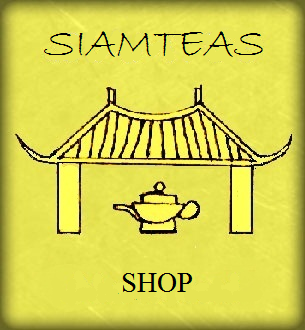
from all over the world



